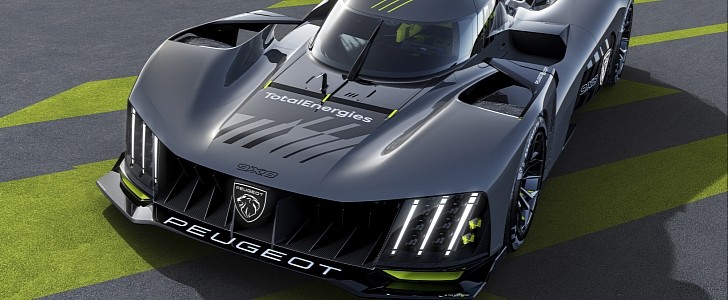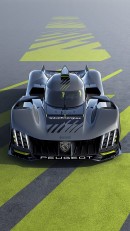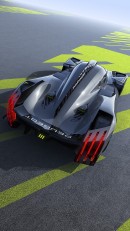As announced in 2020, Peugeot is returning to endurance racing after an 11-year hiatus. And the French company finally unveiled its prototype of choice for the Le Mans Hypercar (LMH) class. It's called the 9X8, it doesn't have a rear wing, and it looks like something from Star Trek just landed on Earth.
Set to debut in the FIA World Endurance Championship in 2022, the Peugeot 9X8 is still a prototype for now. That means the shell will go through a few changes before next season starts, but it's safe to assume that the French won't make significant alternations.
The folks over at Peugeot Sport claim the 9X8 "heralds a new era in motor racing," and I tend to agree with them. And not only because this race car doesn't have a wing. It's also quite different from the Le Mans prototypes we've seen so far. Forget about the familiar sunken nose and tall front wheel arches; this thing is almost flat from the cockpit to the nose.
The rear fin also descends deeper into the rear decklid compared to modern LMP1 racers, while the top of the rear fenders feature an additional set of fins about where the posts of the rear wing should be.
So how did Peugeot manage to design a prototype racer without a rear wing, which is both ridiculous and unheard of? Well, the French firm explains that it had "achieved a degree of aerodynamic efficiency" that allowed it "to do away with this feature." That's pretty vague, but Peugeot stresses that it has "every intention of keeping that a secret as long as we possibly can."
Peugeot also calls it a "major innovative step," which gives me hope that the 9X8 won't be a flop. The last time a carmaker joined the series with an innovative design, things didn't go very well. I'm talking about the front-engined Nissan GT-R LM Nismo.
Out-of-the-box design aside, the 9X8 boasts a strong link to the company's current production model. The massive headlamps and taillights with three claw-like strokes are definitely borrowed from the road cars, as are the Selenium Grey paint and Kryptonite (green/yellow) highlights inside and out.
The "9X8" badge is also a reference to Peugeot's production models. While "9" establishes a link to previous racing prototypes like the 905 and 908 and "X" refers to the company's AWD technology and hybrid powertrain, "8" is the suffix used for all of the brand's current model names, ranging from the 208 to the 5008.
So what's under the hood, you ask? Peugeot paired a rear-mounted, 2.6-liter V8 gasoline engine to a front-mounted motor-generation unit. While the V6 cranks out 680 horsepower, the motor adds another 200 kW (268 horsepower) into the mix. All this oomph travels to all four wheels through a seven-speed sequential gearbox.
As for the battery, Peugeot will be using a "technologically-sophisticated, high-voltage, high-density" 900-volt battery that's being co-developed by Peugeot Sport and Saft. I say "will" because the technology is not yet ready. In fact, it seems that the gearbox hasn't been integrated into the hybrid system either. But everything is in "the process of being assembled in keeping with the bench-testing validation schedule."
If you're wondering if Peugeot plans to roll out a road-legal version of the 9X8, the answer is a firm NO. This thing was developed for racing purposes only. However, some components might make it into production cars in the future.
When Peugeot returns to the World Endurance Championship in 2022, it will be its first prototype racing venture since 2011. That's when the diesel-powered 908 HDi ran its final outing in the championship—that car won both the 24 Hours of Le Mans and the WEC title in 2009.
But this wasn't Peugeot's first success in the series. The French joined top-tier racing in 1990 with the 905 and scored its first two wins at Le Mans in 1992 and 1993. Peugeot also won the World Sportscar Championship in 1992.
The folks over at Peugeot Sport claim the 9X8 "heralds a new era in motor racing," and I tend to agree with them. And not only because this race car doesn't have a wing. It's also quite different from the Le Mans prototypes we've seen so far. Forget about the familiar sunken nose and tall front wheel arches; this thing is almost flat from the cockpit to the nose.
The rear fin also descends deeper into the rear decklid compared to modern LMP1 racers, while the top of the rear fenders feature an additional set of fins about where the posts of the rear wing should be.
So how did Peugeot manage to design a prototype racer without a rear wing, which is both ridiculous and unheard of? Well, the French firm explains that it had "achieved a degree of aerodynamic efficiency" that allowed it "to do away with this feature." That's pretty vague, but Peugeot stresses that it has "every intention of keeping that a secret as long as we possibly can."
Peugeot also calls it a "major innovative step," which gives me hope that the 9X8 won't be a flop. The last time a carmaker joined the series with an innovative design, things didn't go very well. I'm talking about the front-engined Nissan GT-R LM Nismo.
Out-of-the-box design aside, the 9X8 boasts a strong link to the company's current production model. The massive headlamps and taillights with three claw-like strokes are definitely borrowed from the road cars, as are the Selenium Grey paint and Kryptonite (green/yellow) highlights inside and out.
The "9X8" badge is also a reference to Peugeot's production models. While "9" establishes a link to previous racing prototypes like the 905 and 908 and "X" refers to the company's AWD technology and hybrid powertrain, "8" is the suffix used for all of the brand's current model names, ranging from the 208 to the 5008.
So what's under the hood, you ask? Peugeot paired a rear-mounted, 2.6-liter V8 gasoline engine to a front-mounted motor-generation unit. While the V6 cranks out 680 horsepower, the motor adds another 200 kW (268 horsepower) into the mix. All this oomph travels to all four wheels through a seven-speed sequential gearbox.
As for the battery, Peugeot will be using a "technologically-sophisticated, high-voltage, high-density" 900-volt battery that's being co-developed by Peugeot Sport and Saft. I say "will" because the technology is not yet ready. In fact, it seems that the gearbox hasn't been integrated into the hybrid system either. But everything is in "the process of being assembled in keeping with the bench-testing validation schedule."
If you're wondering if Peugeot plans to roll out a road-legal version of the 9X8, the answer is a firm NO. This thing was developed for racing purposes only. However, some components might make it into production cars in the future.
When Peugeot returns to the World Endurance Championship in 2022, it will be its first prototype racing venture since 2011. That's when the diesel-powered 908 HDi ran its final outing in the championship—that car won both the 24 Hours of Le Mans and the WEC title in 2009.
But this wasn't Peugeot's first success in the series. The French joined top-tier racing in 1990 with the 905 and scored its first two wins at Le Mans in 1992 and 1993. Peugeot also won the World Sportscar Championship in 1992.











